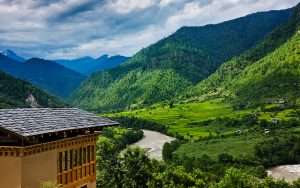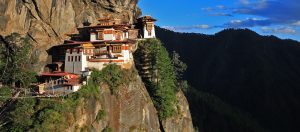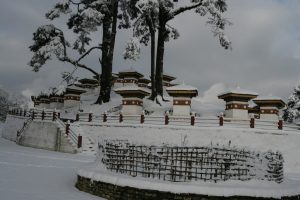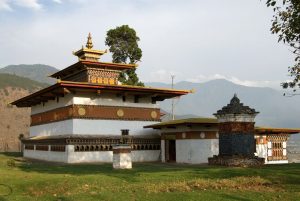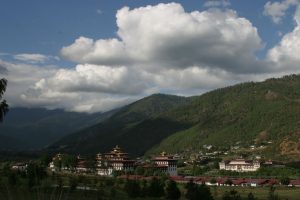- Overview
- Trip Outline
- Trip Include
- Trip Exclude
- Gallery
- Booking
Places to Visit : Thimphu, Paro, Tiger’s Nest Monastery, Punakha
Day 1: Arrival at Paro and Drive to Thimphu.
- Memorial Chorten: The Memorial Stupa, also known as the Thimphu Chorten, is a stupa. It was built in 1974 to honor the third Druk Gyalpo, Jigme Dorji Wangchuck (1928–1972), is a prominent landmark in the city with its golden spires and bells.
- Tashichho Dzong: Tashichho Dzong has been the seat of the government since 1952 and presently houses the throne room and offices of the king, the secretariat and the ministries of home affairs and finance.
- Buddha Dordenma: This massive statue of Shakyamuni measures in at a height of 51.5 meters, making it one of the largest statues of Buddha in the world.
Day 2: Thimphu Sightseeing
- Changangkha Lhakhang: This popular temple, perched like a fortress on a ridge above central Thimphu, hums with pilgrim activity. It was established in the 12th century on a site chosen by Lama Phajo Drukgom Shigpo, who came from Ralung in Tibet. Parents traditionally come here to get auspicious names for their newborns or blessings for their young children from the protector deity Tamdrin
- Takin Zoo: It’s located in the Motithang district of Thimphu. Bhutan is a wildlife reserve area for takin, the national animal of Bhutan. Originally a mini-zoo, it was converted into a preserve when it was discovered that the animals refrained from inhabiting the surrounding forest even when set free.
- National Library: The National Library was established in 1967 to preserve ancient Dzongkha and Tibetan texts. For tourists it is of interest mainly as a fine example of traditional Bhutanese architecture, but there are some great historic photos and on the top floor is a copy of a letter sent from the DrukDesi (secular ruler) to British army officer and surveyor Samuel Turner in 1783.
- Zorig Chusum: This institute, commonly known as 'The Painting School', operates four- to six-year courses that provide instruction in Bhutan's 13 traditional arts. Students specialise in painting (furniture,thangkas – painted religious pictures, usually on canvas), woodcarving (masks, statues, bowls, etc), embroidery (hangings, boots, clothes) or statue-making (clay).
- Folk Heritage Museum: The museum gives you a glimpse of the traditional Bhutanese lifestyle, in addition to artifacts from rural households; it also displays an impressive collection of typical household objects, tools and equipment.
- Royal Textile Muesume: Thimphu's best museum is part of the Royal Textile Academy and is the place to learn about Bhutan's living national art ofthagzo (weaving).
- Drop to hotel/resort.
Day3: Thimphu to Punakha
- Dochula: Dochula pass is located on the way to Punakha from Thimphu. The pass is a popular location among tourists as it offers a stunning 360-degree panoramic view of Himalayan mountain range.
- Druk Wangyal Lhakhang: The Druk Wangyal Lhakhang (temple) was built in honor of His Majesty the fourth Druk Gyalpo, Jigme Singye Wangchuck. The past and future appears to merge in the details of the Lhakhang (temple).
- Chimi Lhakhang: The Chimi Lhakhang Monastery calls for at least one visit when in Punakha. This extraordinary temple is popularly known to be the fertility temple among many and is frequented by childless couples and others alike for blessings.
- Punakha Dzong: The Punakha Dzong, also known as Pungthang Dechen Photrang Dzong (meaning very awesome dzong "the palace of great happiness or bliss"), is the administrative centre of Punakha District in Punakha, Bhutan.
Day4: Punakha to Paro
- Tacho Lhakhang: Located along the Paro – Thimphu highway, across the Paro River is the Tamchog Lhakhang, also known as Tachogang. The great Tibetan saint, ThangtongGyalpo, who is best known as the great iron-bridge builder, built the monastery.
- Ta Dzong: The unusual round building is said to be in the shape of a conch shell, with 5m-thick walls. The Ta Dzong suffered damage in the 2011 earthquake but is due to reopen as the nation's premier museum. Until then a sample of the exhibits are currently on display in an adjacent annexes.
- Paro Dzong: Paro Dzong ranks as a high point of Bhutanese architecture. The massive buttressed walls that tower over the town are visible throughout the valley. It was formerly the meeting hall for the National Assembly and now, like most dzongs, houses both the monastic body and district government offices, including the local courts. Most of the chapels are closed to tourists but it's worth a visit for its stunning architecture and views.
- Drop to hotel/resort.
Day5: Hike to Tiger Nest
- Kichu Lhakhang: According to the Bhutanese legend, the temple dates back to the 7th century, built by the first Buddhist King of Tibet Songtsen Gempo.
- Hike to Tiger Nest: Taktsang Lhakhang is Bhutan’s most iconic landmark and religious site. The name Taktsang translates to “The Tiger’s Nest”. This temple is one of the most holy sites in the kingdom and clings impossibly to a sheer cliff face 900 hundred meters above the Paro Valley.
Day 6: Drop to Airport
- Dumtse Lhakhang: The temple looks like a Chorten and was built in 1433 by the iron iron-bridge builder Thangtong Gyalpo.
- Drop to Airport.
- Private guided tour
- Visas for Bhutan
- Airport transfers
- Daily 3 meals (B/L/D) at designated restaurants or hotels
- Accommodation at 3 star hotel
- A qualified & licensed English-speaking guide
- An experienced driver
- A tour vehicle
- Entry fees & road permits
- Government fee, royalty, taxes & surcharges
- Mineral bottled water
- Flight into Bhutan via Drukair (can be arranged with us)
- Flight on other airline to catch Drukair Flight
- Meals at 4-5 stars restaurants
- Hotel stay outside of Bhutan
- Expenditure of personal nature
- Travel Insurance
- Tips for the guide and driver
- Alcoholic drink



